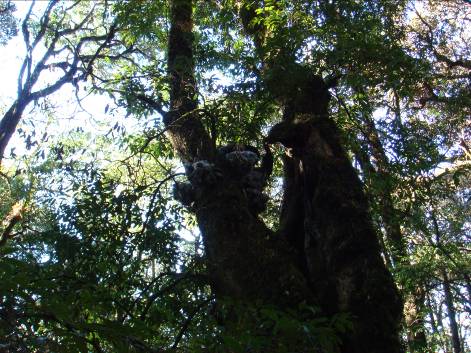Litter decomposition is a fundamental ecological process and provides a major source of nutrients for biological activities in terrestrial ecosystems. In southwest China, montane moist evergreen broad-leaved forests in high altitude (2000–2600 m) are an important global vegetation type, characterized by high humidity and high epiphyte abundance However, information on epiphyte litter decomposition and nutrient release is limited. To investigate the decomposition rates and nutrient release of epiphyte litter in subtropical forests, Prof. LIU Wenyao and his team of Xishuangbanna Tropical Botanical Garden (XTBG) conducted a study in the Xujiaba region (2000–2750 m a.s.l.; 23°35′–24°44′ N, 100°54′–101°30′ E), a core area of the Ailao National Nature Reserve. The researchers compared the decay of five epiphytes (macrolichens Everniastrum nepalense, Nephromopsis ornata and Usnea florida, moss Homaliodendron flabellatum, and fern Phymatopteris connexa) and two tree species (Castanopsis wattii and Lithocarpus xylocarpus) in the canopy and on the forest floor in a primary forest in the Ailao National Nature Reserve. Their main objectives were to characterize changes in decay rate and nutrient release of epiphyte litter (1) between canopy and forest floor habitats (2) among species in subtropical forests. They hypothesized that (1) litter would decay more slowly in the canopy than on the forest floor and (2) epiphyte litter would decay faster than tree litter in both compartments. Their study found that the studied litter decayed 15–30% more slowly in the canopy than on the forest floor in subtropical evergreen broad-leaved forests in southwest China, and thus the result was consistent with their first hypothesis. In partial support of their second hypothesis, they found the order of litter decay rate was lichen > tree > fern > bryophyte. Their study also showed that C and N in epiphytic lichens were readily released during decomposition, accompanied by increasing concentrations. Epiphytic bryophyte decayed the lowest but with relatively rapid release of N and P. Decomposing epiphytic fern had high net N and P immobilization. Their results highlighted the potential importance of nonvascular epiphytes in increasing nutrient availability, especially N and P, in the canopy soil environment, and the probable role of epiphytic bryophytes and ferns in accumulating organic matter. The study entitled “Slower rates of litter decomposition of dominant epiphytes in the canopy than on the forest floor in a subtropical montane forest, southwest China” has been published online in Soil Biology and Biochemistry. 
|

